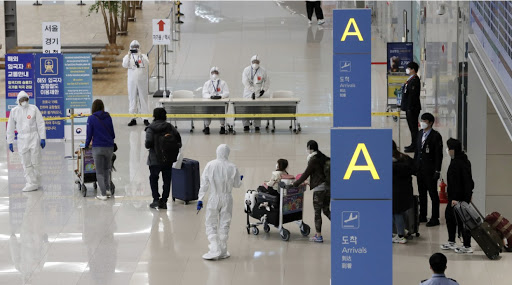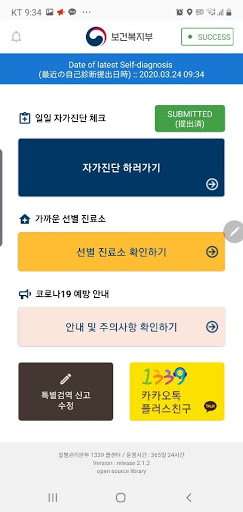Although the daily number of new Coronavirus infections has dropped significantly in Korea, new infections are still popping up from travelers entering the country. Thus, the government decided to require every single person entering the country, citizen and non-citizen, to self-isolate in their homes for a period of 14 days. To track their health and make sure that they are following the guidelines, each passenger is required to download a mobile application on their smartphone.
On March 17th, I arrived at Incheon International Airport at 5:36 AM from Seattle, Washington, and saw that the usual process of going through immigration and customs had been changed. I could see hundreds of people lined up in a single queue to get their body temperature checked. At the end of the line, there were volunteers from the Army, airport personnel, and doctors and nurses ready for emergencies clad in white protective clothing. Silent, every person in the area had a nervous look. While waiting, my family and I were told to install an app called “Self-Diagnosis - Ministry of Health and Welfare” and to complete the self-administered survey on the app for the next two weeks.

We quickly finished the identification process on the app, which required cell phone and passport numbers, and answered several yes-or-no questions about current symptoms including fever, cough, sore throat, and dyspnea. Then, stepping up to the front, I showed my results to the interviewer with trembling hands. He checked the temperature on my forehead, made a notation in an identity information sheet about me, and then allowed me to pass.
Now that I ended this entire demanding task, I had a piece of mind to look around, and what I saw was utter chaos. A group of foreigners from Southeast Asia did not understand how to install the app due to the language barrier, and there were babies waiting such a long time that they cried of hunger. Some people were so frightened by possible exposure to infected people that they kept asking the already busy airport staff about any faster way to get out, telling the staff that they were clearly not afflicted with the virus. I witnessed a stunning scene in the midst of the tumult—despite their limited number, the staff members arduously, responsibly, and methodically took care of all these confrontations. Slowly but surely, things began to settle even though the number of travelers continued to increase.
After that, my two weeks of home quarantine truly began. In fact, home quarantine turned out to be not as difficult as I had expected. I just had two things to follow daily: reporting my symptoms via the app and not going outside.

When I was reporting my symptoms, I never felt any difficulties because the application had a simple, necessary design and provided support for multiple foreign languages such as English and Japanese. I could even edit my response at any later time on the same day. The app also included several features besides the self-survey system. Two additional functions on the main screen allowed the users to access the official government sites, which includes a map for where you could check nearby public health clinics to visit and get tested and a web page where you could find useful guidelines and precautions against the virus.
For KakaoTalk users, the function in the bottom right corner was linked to the Kakaotalk profile of the KCDC (Korea Centers for Disease Control and Prevention). If you add the KCDC account, you might find various campaigns, clips of the everyday briefing at 2:10 PM, and a straightforward visual graph with multiple statistics showing the trends of the outbreak. Every one of them is uploaded on the timeline on a daily basis. Furthermore, you could get an instant, automatic message from the channels about FAQs, major symptoms based on up-to-date research findings, and suspected causes for any changes in the trend of the spread. You could even chat with a human operator 24/7.
As I ended my self-isolation on March 30th, I haven’t inputted my health status into the mobile app since then. The procedure that I had to follow was not an inconvenience at all, and I considered it my duty to perform for the safety and health of others. The system is in place for a reason and has contributed to the dwindling number of infections in the country.

Jaeun Shin
Sophomore (Grade 10)
Seoul Scholars International

